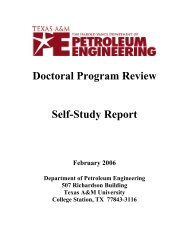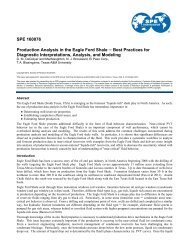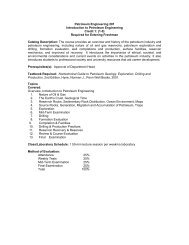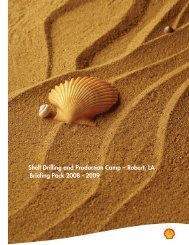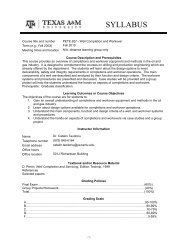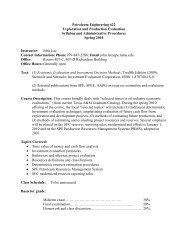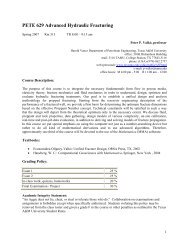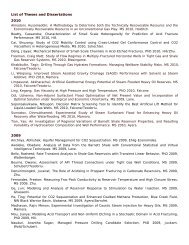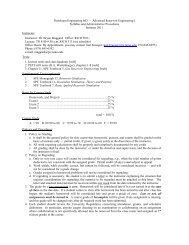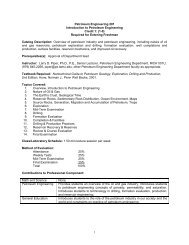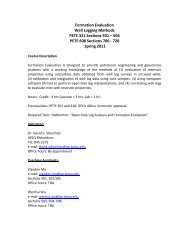Crisman Annual Report 2009 - Harold Vance Department of ...
Crisman Annual Report 2009 - Harold Vance Department of ...
Crisman Annual Report 2009 - Harold Vance Department of ...
Create successful ePaper yourself
Turn your PDF publications into a flip-book with our unique Google optimized e-Paper software.
Decision Matrix for Liquid Loading in Gas Wells for Cost/Benefit Analyses <strong>of</strong> Lifting<br />
Options (Part 2)<br />
Objectives<br />
Liquid loading is one <strong>of</strong> the main drawbacks <strong>of</strong><br />
gas well production. Although there are literature<br />
reviews available regarding solutions to liquid loading<br />
problems in gas wells, a tool capable <strong>of</strong> helping an<br />
operator select the best option for a specific field<br />
case still does not exist.<br />
The ultimate goal <strong>of</strong> this project is to fulfill the<br />
decision matrix tool initiated by a previous graduate<br />
student. Developing the tool itself and adding<br />
more available water unloading options and more<br />
limitations in each technique, using both technical<br />
and economic factors, will complete the full cycle for<br />
this project.<br />
Approach<br />
This project develops and expands the existing<br />
decision matrix tool used to evaluate and screen<br />
the possible available alternatives for dealing with<br />
liquid loading in gas wells. Limitations <strong>of</strong> liquid<br />
unloading techniques from literature reviews and<br />
practical actual data from the industries will be<br />
collected to become a database. A full cycle analysis<br />
<strong>of</strong> a production simulation will then be performed,<br />
emphasizing technical and economic impacts. First,<br />
simulation <strong>of</strong> gas production will be done using a<br />
material balance method. From this, production<br />
pr<strong>of</strong>iles and gas decline rates can be obtained. A<br />
decline curve analysis will also be done if the data<br />
available to confirm the results from the simulation<br />
exist. Then a cash flow analysis consisting <strong>of</strong> the cost<br />
and the benefits <strong>of</strong> each technique will be performed<br />
to obtain economic yardsticks such as NPV or IRR.<br />
Using these yardsticks should provide the most<br />
optimum (practical and economical) unloading<br />
technique to be selected.<br />
Significance<br />
By using this decision matrix tool as a preliminary<br />
screening tool, companies can determine which<br />
technique is the best fit for their conditions. The<br />
operators can also save time and money usually<br />
wasted when considering and trying many different<br />
liquid unloading techniques by themselves.<br />
Future Work<br />
The completed decision matrix is the ultimate goal <strong>of</strong><br />
this project, therefore the types <strong>of</strong> liquid unloading<br />
techniques, the limitations <strong>of</strong> each technique,<br />
the actual set <strong>of</strong> production data from the oil and<br />
gas companies, and the results from production<br />
simulations have to be applied to the decision matrix<br />
codes as much as possible to make this program<br />
provide a good representation <strong>of</strong> each alternative.<br />
Flow diagram for Decision Matrix.<br />
Project Information<br />
2.4.13 Decision Matrix for Liquid Loading in Gas Wells for<br />
Cost/Benefit Analyses <strong>of</strong> Lifting Options (Part 2)<br />
Related Publications<br />
Park, Han-Young: 2008, Decision Matrix for Liquid Loading<br />
in Gas Wells for Cost/Benefit Analyses <strong>of</strong> Lifting Options.<br />
MS thesis, Texas A&M U., College Station, Texas.<br />
Contacts<br />
Gioia Falcone<br />
979.847.8912<br />
gioia.falcone@pe.tamu.edu<br />
Nitsupon Soponsakulkaew<br />
Evaluation Start<br />
Preliminary Screening<br />
- Well information - Production status<br />
- Fluid properties - Reservoir properties<br />
- Power supply<br />
Technical Evaluation using Decision Matrix<br />
- Technical Efficiency - Reserves information<br />
- Production pr<strong>of</strong>iles - Production Decline Rate<br />
Economic Evaluation<br />
- Economic yardsticks (NPV, IRR)<br />
Final Selection and Ranking<br />
CRISMAN INSTITUTE<br />
54<br />
<strong>Crisman</strong> <strong>Annual</strong> <strong>Report</strong> <strong>2009</strong>



